Coming Home: Geoffrey Beene
May 5, 2024 – January 24, 2025

Geoffrey Beene (1924-2004), originally from Haynesville, Louisiana, was a legend of American fashion design who won eight Coty Awards and two Council of American Fashion Designers awards in his forty-year career. This retrospective exhibition features the collection of Sylvia R. Karasu, MD, with garments from the 1960s through the early 2000s, supplemented with fashion sketches. More info about the exhibition.
Geoffrey Beene (1924-2004), originally from Haynesville, Louisiana, was a legend of American fashion design who won eight Coty Awards and two Council of American Fashion Designers awards in his forty-year career. This retrospective exhibition features the collection of Sylvia R. Karasu, MD, with garments from the 1960s through the early 2000s, supplemented with fashion sketches.
Coming Home: Geoffrey Beene was curated by graduate students from the Department of Textiles, Apparel Design, & Merchandising, supervised by Dr. Mamp.
Student Curators: Md Nazmul Haque, Chloe Johnson, Lauren E. Lansdell, LaDyra Lyte, Mfon-ABasi Obong, Aja Palermo, Elizabeth Schick, Morgan Strzynski, MG Taylor, Penelope Williams & visiting scholar Camila C De Albuquerque Oliveira with the assistance of undergraduate student workers: Martha Rigney & Olivia Ryland.
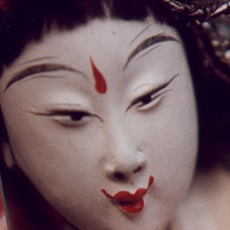
Exhibition Dates: January 17- May 21, 1993
A World of Dolls showcased the collection of dolls donated to LSU by former professor of speech and costume design, Edith Dabney, along with other dolls in the University's collections and several on loan. The dolls dated from the eighteenth to the twentieth centuries, originated from around the world, and included antique European and American dolls as well as prehistoric, American folk-art and Native American dolls. The dolls were exhibited with related books from the LSU Library's Rare Book Collection at Hill Memorial Library and with textile and costume items from the Textile & Costume Museum's collections in the Museum's Gallery. Visit the World of Dolls virtual scrapbook.
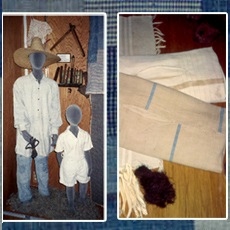
Exhibition Dates: October 1, 1994 - March 31, 1995
To coordinate with the 1994 world celebration of the International Year of the Family, the LSU Textile & Costume Museum gathered Acadian textiles, garments, household furnishings, and textile related tools from various private and public collections as well as from its own holdings. The exhibition had as its design to illustrate the following: the importance of textiles in the daily lives of Acadian families living in southern Louisiana; the various aspects of the production, use, and care of textiles by Acadian families in the late nineteenth and early twentieth centuries; and, the relationships between family heritage and textile production and use. Included were rare patchwork quilts made from "cotonnade" hand woven garment fabrics and "bouton" and "cordon" hand woven bedspreads with hand knotted fringes. Along with many sheets and blankets were some of the few remaining examples of hand woven garments. Carding, spinning, and weaving tools and equipment used for washing and ironing illustrated production and care of textiles. Acadian Textile Terms (Rabalais and Crousillac, 1994) defined unique Acadian terms. Also included was an overview of the 1938-1962 Acadian Handicraft Project whose promotion of the Acadian culture and traditions involved Gladys Clark, an active weaver continuing her own family's weaving tradition.
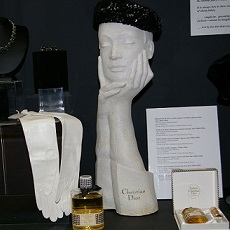
Exhibition Dates: March 2010 - June 2011
This exhibition introduced the visitor to Christian Dior’s mid-century fashion influence, from the launch of his first collection of women’s garments in 1947, immediately dubbed the “New Look,” to the last he created before his untimely death ten years later. Because the House of Dior’s initial line was so highly publicized in European and American fashion periodicals and in the American popular press, original copies of Vogue, Harper’s Bazaar, and Life magazines were mounted as evidence of his widespread impact. Retail store ads in local newspapers such as Baton Rouge’s State Times and Morning Advocate and LSU’s annual Gumbo yearbook of student life contained references to the popular New Look innovation in fashion and were used to support local interest. Period Dior garments purchased at retail in New York and garments altered by Baton Rouge residents to mirror the New Look’s longer hemline served as tangible evidence. To illustrate the continuance of Dior’s design expertise as a source of inspiration today, the contemporary creative work of an LSU graduate student was included in the exhibition.
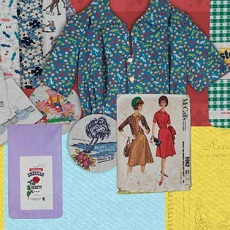
Exhibition Dates: April 2005 - June 2006
Commodity bags, woven fabric bags that originally packaged products such as animal feed, flour, sugar, and salt, were an important resource in home sewing for women from the 1930s through the 1960s. The exhibition Converting Commodity Bags: Recycling Circa 1940 educated visitors about commodity bags, their history, and the many ways they were used by industrious women, particularly in rural areas, to clothe their families and decorate their homes in the mid-twentieth century. Numerous examples of clothing and home textiles made from commodity bags by Louisiana women were highlighted. This exhibition has become a traveling exhibit available to smaller sites in the region. Visit the Converting Commodity Bags virtual scrapbook.
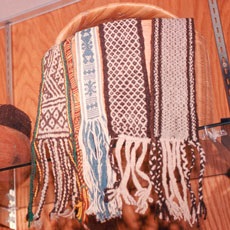
Exhibition Dates: September 4 - October 30, 1992
The exhibition Costumes of Mexico was produced through the cooperation of the LSU School of Human Ecology and the university's Mexican Student Association and was the first exhibition in the newly-established Museum Gallery. Because dress in Mexico ranges from the most current of international fashions found in Mexico City to centuries-old forms of traditional dress worn in isolated villages, a practice becoming increasingly rare in the world. The later was chosen as the focus of the exhibit. Exhibited artifacts illustrated the country's Indian population in its retention of ancestral forms of dress, using variations to distinguish individual villages and wearing elaborately woven and embroidered clothing in their everyday lives. Costumes and textiles from six states and ten different cultural groups were included and provided a glimpse of the wide variety of textiles and styles of dress that are worn in Mexico's thirty-two states by more than fifty different Indigenous peoples.
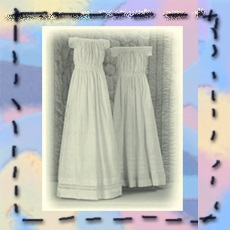
Exhibition Dates: January - December 1997
The exhibition Dream Stitches took the viewer back in time and into the world of an expectant Mother at the turn of the twentieth century as she dreamed and stitched a clothing layette for her baby. While the exhibit focused on articles for the layette that were made at that point in time, garments dating from 1854 through the 1930’s were included. The wide variety of clothing ranged from every day necessities to those made for special occasions. Bonnets and gowns, varying in design from simple to exquisitely tucked and frilled, were among the items featured. Information about fine hand-sewing techniques and customs regarding infants and their clothing was highlighted. Period portrait photographs of Victorian infants from the studio of Henry C. Norman of Natchez, Mississippi, complemented the exhibited artifacts. The photographs for this special feature were selected from the collection of Joan W. and Thomas H. Gandy. Booklets made by Louisiana high school home economics students as class assignments in 1926 depicted items that would be included in a baby’s layette along with garment illustrations, fabric samples, and projected costs. Visit the Dream Stitches virtual scrapbook.
Exhibition Dates: September 2011 - July 2012
Dressed for Eternity: Mid-Nineteenth Century Burial Dress in Louisiana featured burial
clothing recovered from cast iron coffins located in St. Joseph Cemetery in Thibodaux,
Louisiana, as well as replication garments based on archeological evidence. The period
garments were that of two adult women and a young female and male and included: a
lady’s nightgown, undersleeve, chemisette, and petticoat; a male burial shroud (a
burial-specific garment similar to a nightgown), dress shirt, and bow tie; and a girl’s
dress, bonnet, and shoes with gold-embossed angels.
Period postmortem photographs were used to illustrate dress of the deceased and its
relationship to the two most prevalent death metaphors of the time: when buried in
nightwear, death was depicted as eternal sleep while street wear presented death as
a long journey.
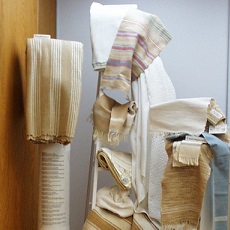
Exhibition Dates: February 27 - June 30, 2000
The Louisiana State University based Acadian Handicraft Project, its origins, its dynamic director Louise Olivier, its craftspeople, and the success of its preservation efforts as evidenced long after its end was examined in Giving the Cajuns a Lift. The exhibit informed the viewer not only of Olivier’s extraordinary efforts to promote traditional Acadian handiwork such as hand weaving, palmetto braiding and French hand sewing, but also of a post World War II cottage industry that grew out of her passion, in an era before many women in rural south Louisiana communities sought employment outside the home. Original project records and correspondence, oral histories obtained from craftspeople, and extant artifacts bearing the Acadian Handicraft label enhanced the exhibition and documented the project’s accomplishments. Visit the Acadian Handicraft Project virtual scrapbook.
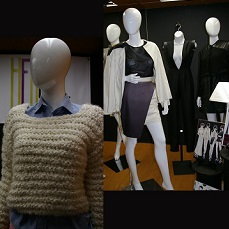
Exhibition Dates: June 2014 - October 2014
Hemline@LSU is a student organization that is dedicated to promoting fashion creativity and awareness among LSU students and the local community. The exhibit Hemline@LSU: Students Promoting Fashion & Philanthropy features promotional materials, photographs, and fashion designs from several of the organization’s events in the 2013 - 2014 academic year: Hemline@LSU’s annual fashion show; a trunk show featuring area designers and retailers; a philanthropic experience; and a meeting with fashion celebrity Mondo Guerra, the 2012 winner of Lifetime Television’s Project Runway All-Stars. Included in the exhibit were pieces designed and constructed by the organization’s student members: gowns made of red paper hearts created for the American Heart Association’s campaign Go Red for Women and winning garments showcased in Hemline@LSU’sannual fashion show. Featured student work is that of senior Victoria Beadles and freshman Whitney Sylvain (Go Red For Women finalists), senior Maddie Louviere (“Best in Show”), senior Alex Engelhardt (“First Place Senior Design”), and junior Kristin Ament (“First Place Junior Design”).
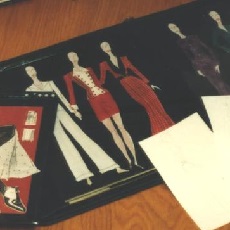
Exhibition Dates: October 1, 1993 - May 1, 1994
To highlight Louisiana State University's apparel design program, its student design accomplishments, and the importance of historic dress as inspiration in the design process, the works of three School of Human Ecology students were chosen for Design Inspiration. Each student's project was paired with its corresponding inspiration pieces from the museum's holdings and represented the 1930s, 1940s, and 1950s decades. A series of student-produced illustrations diagrammed the step-by-step design process involved, from initial idea to final product.

Exhibition Dates: October 2013 – January 2014
“Some little girls dream of their wedding dress. I dreamed of everyone else’s.”
New Orleans dress designer, LSU alumna, and author of “Designing in Ivory and White,” Suzanne Perron specializes in the custom design of bridal, debutant, and Mardi Gras gowns using couture techniques, such as fabric manipulation, hand beading, and lace sculpting. The exhibit In the Couture Tradition: The Gowns of Suzanne Perron featured Rex Maid, Queen, and bridal gowns, one of which was Suzanne’s own wedding dress. Suzanne graduated with top undergraduate honors from LSU and attended a one-year accelerated program in fashion design at the Fashion Institute of Technology in New York City where she received the Bill Blass Award, which recognized her as the outstanding graduate of her class. Following her education, Perron accepted positions at Carolina Herrera, Anna Sui, Ralph Rucci, Christina Perrin, and Vera Wang before moving home to New Orleans and opening her own studio.
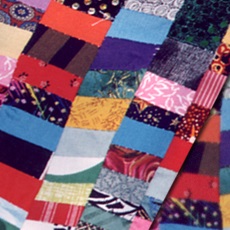
Exhibition Dates: October 4, 1998 - March 1, 1999
This exhibition introduced the visitor to Anna Williams and her quilts, painting a portrait of her from her childhood on Baton Rouge's Kleinpeter Plantation to her present international reputation as an art quilter. The improvisational aspects of Anna’s quilting were illustrated through comparisons of her quilts with the traditional quilt blocks from which her work stems. The continuity of Anna’s growth as an artist was demonstrated by a quilt series that illuminated the progression of her work in one particular pattern. Pieced quilt blocks developed by elementary school children after their introduction to Anna and her work showed her influence on a new generation of Louisianans. Oral history excerpts and photographs of her home reveled how Anna's use of color define not only her quilts but also other aspects of her life and further illustrate her unique and expressive self. Visit the Joyful Improvisations virtual scrapbook.

Exhibition Dates: February 2014-March 2014
The inspiring portfolio of knotted fiber pieces and modern bead work of Baton Rouge resident Jane Olson-Phillips was the basis for Knot Just Beads: Works by Bead/Fiber Artist Jane Olson-Phillips. The exhibit encompassed over 100 works by the artist and international bead, stone, and fossil collector, and included jewelry composed of antique and new hand-made beads, knotted fiber jewelry, painted clay tile and knotted fiber wall art, and clay masks. Beads ranged in material type from glass, stone, fossil, wood, metal, ceramic, plastic to clay. The knotted fiber work presented used both natural and synthetic fibers. Supplementing Phillips’s work was antique and vintage jewelry pieces that she donated to the LSU Textile and Costume Museum.
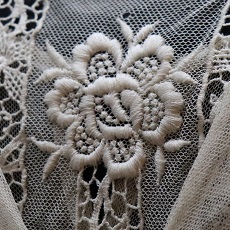
Dates: January 2016 - Fall 2017
Past ExhibitsLingerie Redefined: Iconic Yet Overlooked Everyday Fashions 1900s-1920s examines a type of mainstream turn-of-the-century women’s dress that incorporated the same embellishments and trimmings as those adorning period undergarments. Through the use of period garments, accessories, advertisements, and photographs, the story of this readily-identifiable style is revealed. Included in the exhibition are artifacts representing the three distinct periods that surround World War I: Pre-War (1900-1913), Wartime (1914-1918), and Post-War (1919-1929). At the height of its popularity during the earliest period, the lingerie dress was a highly-desirable, instrumental piece in any woman’s wardrobe. Lingerie Redifined virtual scrapbook.
Exhibition Dates: June 2013 - September 2013
Today, New York and Paris are global partners in the international world of fashion. The relationship between these two cities was quite different at the turn of the twentieth century when Paris was the western world’s design source for fashionable dress and Americans closely followed French dictates. Paris and New York: A Tale of Two Fashion Cities showcased western world fashion, c.1900 – 1950, guiding visitors through the United States’ development of its world-renown, ready-to-wear manufacturing industry. The exhibition concluded with American designers who rose to the challenge of World War II’s material shortages, an event that brought New York to the fashion forefront and firmly established the city as a world fashion center and a fashion source for the French.
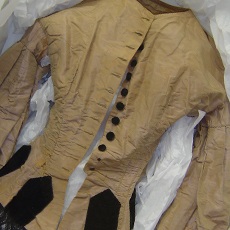
Exhibition Dates: November 2003 – October 2004
When the French government presented Louisiana to the United States on December 20, 1803, Pennsylvania native Thomas Butler III was studying law and Ann Madeline Ellis was a young Natchez eight-year-old. The exhibition Preserving Heritage Through One Family’s Treasures: The Louisiana Purchase Years and Beyond introduced the visitor to Thomas and Ann and their family through apparel artifacts carefully packed away in the attic of their Louisiana West Feliciana plantation home, The Cottage. Original correspondence not only documented family relationships and daily life, but also commented on state and national historical and political events. Clothing expenditure receipts and period fashion plates were correlated with exhibited garments to position the extant pieces within the historical period. Textile conservation methods were illustrated and provided the visitor with instruction for his own preservation project. The documentation process as part of museum accessioning and the community access resulting from inclusion in a public institution were emphasized and support the importance of such a collection to Louisiana citizens.
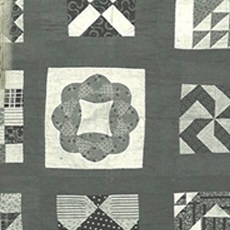
Exhibition Dates: March 1 - May 29, 1998
Quilting can be viewed from three different aspects: the object, the process, and the maker. All of these are influenced by the culture in which they are produced and were addressed in the exhibition, Quilts of the Cane River Plantations. The quilts in the exhibition were brought together for the first time, spanned over 100 years of southern quilting, and illustrated the development of American quilting in both size and style. Both fancy and plain quilts were shown together as domestic products used by planter families in one of the oldest plantation areas in Louisiana. A variety of quilt types, such a whole-cloth, block, appliqué, pieced, embroidered, scrap, and purchased-fabric quilts, were represented. Associated tools, period artifacts, photographs, and related aspects of family and plantation histories were exhibited with the quilts to enhance the interpretation of female quilt makers and plantation culture in Louisiana history and provided an intimate view of the lifestyles behind the pillars and porticos of the plantation home. View the Quilts of the Cane River Plantations virtual scrapbook.
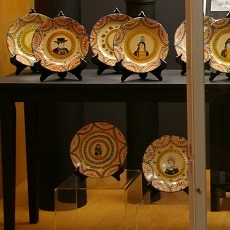
Exhibition Dates: October 2012 - May 2013
The LSU French House, or La Maison Française, was established in an effort to preserve
the French language, literature, and culture in Louisiana. The house was modeled
after a French manor house and served as a residence where students could study French
culture by conversing in French and eating traditional French cuisine.
The French Connection: LSU 1936 featured the Quimper tableware purchased exclusively
for the house in the town of Quimper in the Brittany region of northwestern France.
Anita Olivier Morrison, housemother or chatelaine of La Maison Française, obtained
the pottery while traveling in France in the summer of 1936. The exhibit contained
120 pieces of the pottery lavishly decorated with colors, scenes, and male and female
figures that are reflective of the region’s heritage. Also featured in the exhibit
were images of traditional Breton dress, which developed in Brittany after the French
Revolution (1787-1799) in affirmation of the cultural differences of its population.
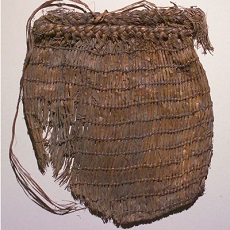
Exhibition Dates: April - August 1999
Threads and Treads of the Past featured prehistoric textile remains analyzed by researchers in the LSU Archaeological and Historic Textile Laboratory that were recovered from three archaeological sites: Arnold Research Cave in Callaway County, Missouri; Avery Island in Iberia Parish, Louisiana; and Bayou Jasmine in St. John the Baptist Parish, Louisiana. These textiles, which would have perished under normal environmental conditions, were preserved because of the special circumstances of their deposits: the dry natural bluff shelter of the Arnold Research Cave, the unique saline conditions found at Avery Island, and the constantly wet, anaerobic environment at the bottom of Bayou Jasmine. Dated examples of footwear from Arnold Research cave documented more than 7000 years of footwear production at that site. One example, dating to ca. 6265 B.C., is the oldest known example of North American footwear east of the Rocky Mountains. Along with the footwear were numerous pieces of twisted, plied, and braided cordage, and twined fabrics that included a nearly complete bag (ca. 800 B.C.) made from rattlesnake master leaves (eryngium yuccifolium). One dated example from Avery Island (ca. 2800 B.C.) is the oldest known flexible fabric from Louisiana and among the oldest in the Southeast. The examples of fine braided cordage from Bayou Jasmine (ca. 1500 B.C.) varied in number of strands from 4 to 10 and are thought to have played an important part in prehistoric fishing technology. View the Threads and Treads virtual scrapbook.
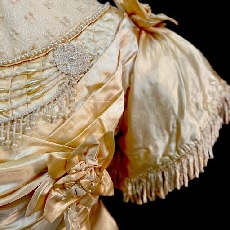
Exhibition Dates: April 16, 2023 – August 31, 2023
The LSU Textile & Costume Museum’s exhibition ‘Til Trends Do Us Part: A Retrospective of Changing Fashion in Bridal Wear will feature approximately 200 years of extant pieces from the Museum’s wedding dress collection. When viewed as a whole, the chronologically arranged garments will illustrate to the visitor the continuum of change in silhouette, design detail, and fabric that are distinctive to this extended period in western fashion history. Information about social and political events influencing popular culture and fashion will supplement the learning experience. News reports and etiquette advice will further contextualize changing trends. Images of celebrity brides and other memorable women add a nostalgic note to the exhibition enabling viewers to experience weddings throughout the decades. ‘Til Trends Do Us Part virtual scrapbook

Exhibition Dates: November 1995 - November 1996
The exhibit Timeline LSU was conceived to be a part of the University’s "Rekindle the Spirit" campaign and designed to illuminate LSU history and student dress from the 1920s through 1970s. Student perspective was emphasized by the inclusion of period student publications, such as the Gumbo yearbook and the Reveille student newspaper in addition to excerpt from oral histories of former students. Scenes for each decade were based on dominate themes in student life and ranged from the first scene in the 1920s that featured a Reserve Officer Training Corp uniformed cadet to the last scene illustrating the landmark period when young women were allowed for the first time in the history of the university to move into off- campus apartments, the 1970s. A purple and gold case included the now defunct freshman male beanies and arm bands, athletic letter sweaters, and other LSU memorabilia.
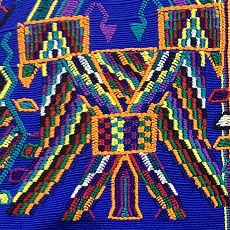
Exhibition Dates: August 30, 2021 - December 4, 2022
This exhibition features the Travis Doering Collection of textiles and related artifacts from 40 villages in the Guatemala highlands. Trajé, or traditional dress, has deep cultural significance to the Maya people. The tradition of weaving and use of symbolism has been passed from mothers to daughters for hundreds of years and supports the legacy of craftsmanship that defines the Guatemalan Maya culture. Traditional dress is primarily still worn by women and includes colorful backstrap loom-woven huipiles (blouses), cortes (skirts), cintas (headdresses), rebozzos (shawls), and fajas (belts), examples of which are mounted in the gallery for public viewing. Visit the Trajé, Maya Textile Artistry virtual scrapbook.
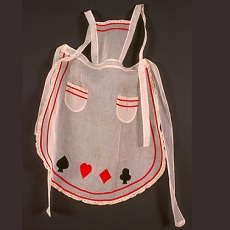
Exhibition Dates: April 2002 - August 2003
Twentieth Century Cinderellas featured women’s housekeeping garments from 1900 to 2000, viewed as unique in time period, form, and function. Exhibited aprons reflected fashion changes as well as changes within American culture during the landmark century. A turn-of-the-century dusting cap, a 1910s full sleeved bungalow apron, and a brightly-colored c.1970 butcher apron were representative of shifts in silhouette, fabrication, and embellishments that marked the one-hundred-year period of apron styles. Aprons used as vehicles for self expression included “message” aprons such as souvenir aprons and aprons and those with imprinted sentiments. “Handmade” aprons allowed the maker to express herself not only in color choice and surface design but also fabric type, whether woven gingham, crochet, patchwork, handkerchief, dishtowel, or of feed sack origin. Aprons chosen to acknowledge “Special Occasions” in entertaining included fancy holiday and party aprons such as a card party apron. “Job Specific” aprons illustrated how housekeeping has taken different forms through the century and so have the design of aprons for certain tasks. Servant aprons with matching collars and cuffs (common prior to World War II), an apron with knee pads for floor cleaning post-1940s, and clothespin aprons were included as a reminder of the changing needs in apron wardrobes. Commercial apron patterns, Good Housekeeping ads featuring women in aprons, and catalog pages offering aprons for sale supported the exhibited aprons and further illustrated twentieth century aprons as being unique in time period, form, and function. Visit the Twentieth Century Cinderellas virtual scrapbook.
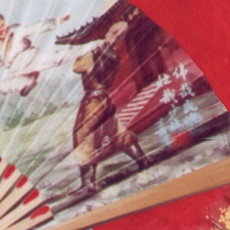
Exhibition Dates: September 18 - November 10, 2000
The exhibition Unfolding Expressions featured selected hand fans from the collection of Opal Spindler of New Orleans, Louisiana. Included in this extensive and diverse collection were souvenir, autograph, mourning, and advertising fans made from multiple fabrications including paper, fabric, feather, lace and parchment. Fans shown represented various construction techniques resulting in folding, flat, frise', cabriolet, and cockade fans. The exhibited fans encompassed western fashion fans as well as ethnographic fans and spanned two centuries. Of special interest were a souvenir fan from the 1904 St. Louis World's Fair and autographed fans from the late 1800s and early 1900s that became personal mementos of events and parties. One read like a scrapbook with the signatures of its male participants, recording their universities and graduating classes as well as personalized remarks.
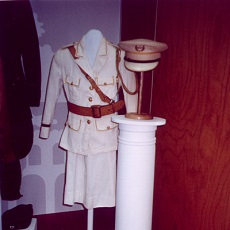
Exhibition Dates: April 2001 - February 2002
As Louisiana State University celebrated the 75th anniversary of the dedication of its current site, What We Wore Under Oaks and Arches commemorated the campus’s past by looking back to the students, faculty, and staff who first walked under its magnificent oaks and through its stately arches. Overseeing the dedication on April 30, 1926, was LSU President Thomas D. Boyd whose black silk vest was featured in the exhibition along with a silk top hat belonging to Dr. Charles Coates, one of the student body’s most liked faculty members from the early years and coach of the university’s first football team. A major proponent of the University’s continued growth and enhancement and supporter of the first student-elected “Darling of LSU” was state governor and later congressional senator Huey Long. A velvet floor-length dress and hat worn on the evening of December 13, 1935, by the first female student to accept the title, Miss Ursula Compton (Kent), documented the event. Uniform jackets from Julie Bonnette (Martin) and Larry Landry, both cheerleaders for the University’s football team and his LSU boxing team robe, athletic letter sweater, and University’s mandatory military training for all entering male students was also evidenced by the uniform of another student, Dorothy Colvin (Howell), a female sponsor for the cadet corps’ military band. A 1947 cheerleader uniform worn by Mary Sue Disch (Maeder) and featured on the front page of the New Orleans States newspaper on December 6, 1947, attested to the largest crowd ever to witness a non-bowl football game in the South. Student activities outside of the classroom included "tea dances", fraternity parties, sorority functions, and snow days and were represented by garments worn by Sarah Hoyt (Minor) and Walter Peevy. The return of servicemen to university studies following World War II was documented by the dress suit worn by Alfred Platte to a Sunday evening movie in “Tiger Town”. Period photographs of featured students supported the exhibited dress.
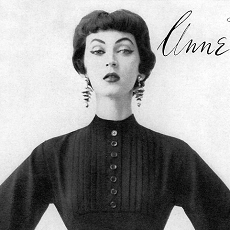
Exhibition Dates: October 1, 2023 - March 28, 2024
Women Fashioning Women examines the hidden history of women fashion designers. This exhibition will feature the work of twenty or more women fashion designers of the twentieth century. Ironically, in an industry fueled and supported by women, the accomplishments of woman fashion designers have been limited to the repetitive stories of trailblazers such as Chanel and Schiaparelli. We reaffirm the essential contributions of couturiers such as Chanel, Lanvin, and Schiaparelli but expand the conversation to examine the work of woman designers such as Vera Maxwell, Anne Fogarty, Ceil Chapman, Elizabeth Hawes, and many more. With a wide range of artifacts pulled from the holdings of the LSU Textile & Costume Museum and others borrowed from partner institutions, we respond to the assessment of feminist and theorist Bell Hooks, who said, "To be in the margin is to be part of the whole but outside the main body" (Hooks, 2015, p. xvii). Women Fashioning Women repositions the accomplishments of influential but oft-forgotten woman fashion designers solidifying their place in the main body of fashion history.
